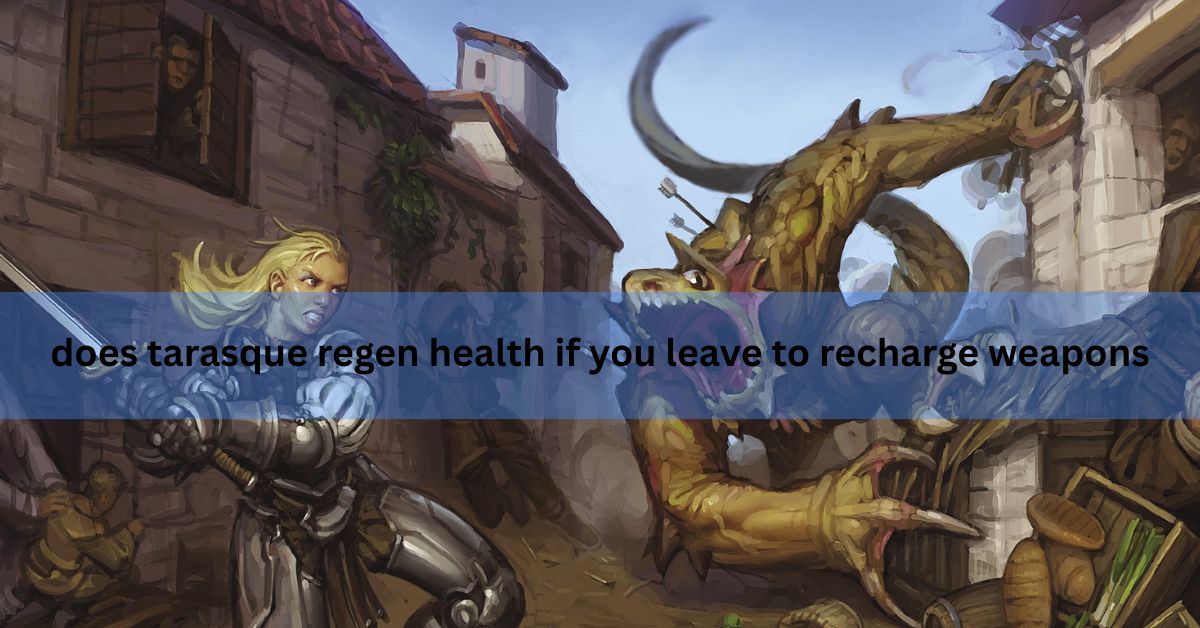Does Tarasque Regen Health If You Leave to Recharge Weapons – Understand Health Regen!
The Tarasque—a legendary beast featured in many tabletop RPGs and video games—has become a modern symbol of indestructibility and epic boss-level endurance. Whether you’re facing the Tarasque in Baldur’s Gate 3, Dungeons & Dragons, or a modded game environment, one of the most common questions players ask is:
“Does the Tarasque regenerate health if you leave to recharge your weapons?”
In this article, we’ll break down this scenario from both mechanical and strategic perspectives. Whether you’re managing limited resources in the heat of battle or planning a long-term takedown of this behemoth, understanding how the Tarasque behaves in different combat systems will give you a serious edge.
What Is the Tarasque in Gaming Lore?
Before diving into mechanics, let’s take a moment to appreciate the mythic stature of the Tarasque. Originating from French folklore, this dragon-like monster is often depicted as an almost unkillable titan. In Dungeons & Dragons (D&D), it is one of the most iconic creatures with near-legendary resistances, immunities, and regenerative properties.
Tarasque traits usually include:
- Huge health pools
- Immunity to magic and debuffs
- Regeneration or fast healing abilities
- Relentless aggression against players
These traits make it one of the most feared enemies—designed to test every aspect of player strategy.
Game Context Matters: Understanding Health Regeneration Mechanisms

The behavior of the Tarasque depends heavily on which game system or version you’re engaging with. Let’s explore a few:
1. Dungeons & Dragons (5e)
In official 5th Edition (5e) rules, the Tarasque does not have a health regeneration ability by default. Once injured, it stays injured—unless the DM (Dungeon Master) homebrews a rule or introduces some divine intervention.
Key Insight: If you flee mid-combat to regroup or recharge weapons (like recharging a wand or switching magic items), the Tarasque’s health will not auto-regen in core rules. However, Legendary Resistance allows it to ignore effects like banishment or polymorph, which means you still need to act fast and finish the job.
2. Baldur’s Gate 3 or Other RPG Adaptations
Some modern RPGs include auto-regeneration mechanics for bosses when players disengage for too long or leave the instance.
Player Warning: In certain game engines, if you exit combat for more than a specific time window, the encounter may reset, meaning the Tarasque’s HP is fully restored. This mimics MMOs or real-time RPG logic rather than tabletop rules.
3. Homebrew Campaigns and Mods
In player-created modules or homebrew campaigns, DMs often enhance the Tarasque by adding regeneration as a combat mechanic.
For example:
- Regenerates 20 HP per round unless dealt fire or acid damage.
- Restores to full health if players flee more than 3 turns.
- Respawns if not destroyed by a specific artifact.
Strategic Note: Always clarify with the DM or mod creator before assuming whether leaving combat gives the Tarasque a free reset.
Do weapons automatically recharge after battle?
In some video games, weapons with energy or durability systems may automatically recharge after battle, especially in sci-fi or fantasy settings. However, in tabletop RPGs like Dungeons & Dragons (D&D), most magical weapons or items require a long rest, charges, or DM intervention to regain power. Automatic recharge is not standard in D&D unless specified by the item’s description.
Also Read: How to Become a Nurse with a Health Science Degree – A Comprehensive Pathway Guide!
How Does Weapon Recharge Work in These Scenarios?
Before worrying about health regeneration, understand what it means to recharge weapons in your game:
- In D&D, recharging usually refers to waiting for long rests or short rests (which may span hours).
- In video games, recharging could mean switching weapons, refilling ammo, or using cooldown mechanics.
If you step out to recharge, you’re introducing a gap in the combat timeline, which many systems use as a trigger for enemy regeneration, repositioning, or resets.
If I leave and return, will initiative be re-rolled?
Yes, in most tabletop RPG systems like Dungeons & Dragons, initiative is re-rolled when a new combat encounter begins. If a creature like the Tarrasque is reset or players leave and re-engage later, it typically triggers a fresh initiative roll. This ensures fairness and reflects the changing dynamics of a new battle.
Tactical Considerations: Is It Worth Leaving the Battle?
Let’s weigh your options:
When You Should Leave:
- Your party is on the brink of death, and a reset is worth the risk.
- Your weapons or items are on complete cooldown.
- You need to replenish essential consumables like healing potions or spell slots.
When You Shouldn’t Leave:
- You’ve already taken the Tarasque below half HP, and losing progress would be devastating.
- The Tarasque has a known health reset mechanic.
- You have debuffs or crowd control abilities active that will expire on disengagement.
Pro Tips to Prevent the Tarasque from Regenerating:

1. Assign Rotational Damage
Keep a rotation of ranged and melee fighters to maintain combat pressure while others recharge.
2. Stagger Rest and Recharges
If playing in a tabletop format, stagger rests so that at least one party member is always engaging the creature.
3. Use Damage-over-Time Effects
Even if it’s resistant, persistent DOTs (like acid or fire) can slow down regeneration and prevent resets.
4. Establish Combat Persistence
In RPGs, make sure one character stays within the combat instance radius to prevent full resets.
Lore-Based Interpretations: Why the Tarasque Might Regenerate
From a narrative perspective, some DMs or game designers may implement health regeneration for the Tarasque to symbolize its:
- Divine-level stamina
- Connection to ancient magic
- Reinforced physiology
Thus, regeneration might not just be a mechanic—it could be part of the story you’re playing through.
FAQ’s:
1. Does the Tarasque regenerate HP in Dungeons & Dragons 5e?
No, the base version of the Tarasque in D&D 5e does not have regeneration, but a DM can add it via homebrew.
2. Will the Tarasque regain full health if I flee in Baldur’s Gate 3?
Yes, most likely. Many RPG systems reset boss encounters if players disengage for too long, including HP reset.
3. Can a weapon be recharged mid-combat in D&D?
Generally, no. Magic item recharge often requires short or long rests.
4. Does damage-over-time prevent the Tarasque from regenerating?
It can in some homebrew versions. Effects like fire or acid may suppress regeneration if that rule is applied.
5. How long can I be away before the Tarasque resets in video games?
Typically, if you’re out of combat for 10–60 seconds, the game may consider the encounter disengaged.
6. Are there any official Tarasque variants with regeneration?
Not in core D&D 5e, but older editions or third-party books may include such versions.
7. Can I pause the battle to recharge and resume later?
Only if the system allows persistent world states. Most don’t and will reset the fight.
8. Should I risk recharging or fight until the end?
If the Tarasque doesn’t reset health, it might be worth staying. If it does, coordinate a quick recharge with ongoing combat pressure to avoid total reset.
Closing Thoughts:
The Tarasque is not just a monster—it’s a test. Whether it regenerates health when you leave to recharge weapons depends on your game system, your DM’s rules, or the game’s engine logic.
The safest route? Treat every encounter as if regeneration is a possibility and plan accordingly. Ensure you understand your game mechanics, communicate with your party, and stay engaged in combat to finish what you started.
Read More:






